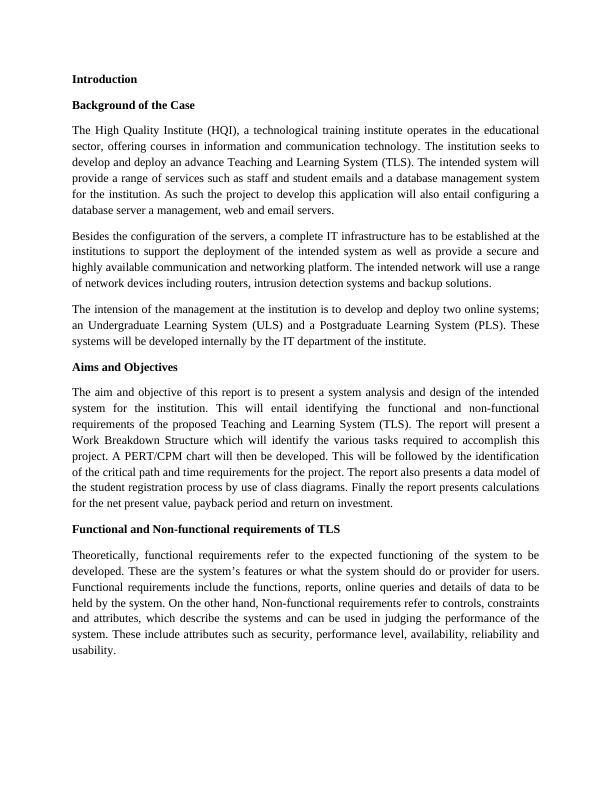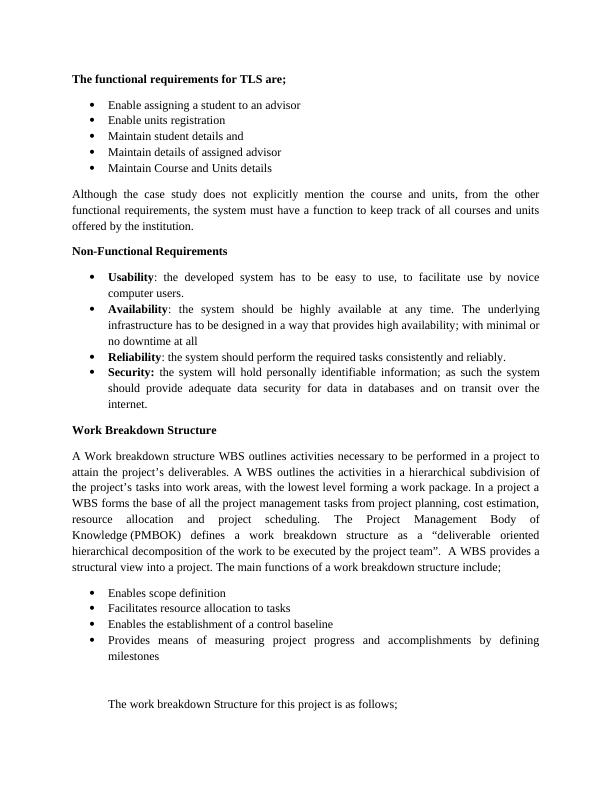High Quality Institute (HQI) Case Study Report
10 Pages1690 Words57 Views
Added on 2020-04-07
High Quality Institute (HQI) Case Study Report
Added on 2020-04-07
ShareRelated Documents
HIGH QUALITY INSTITUTE (HQI) CASE STUDYBy Student’s NameDate:Course Code:

IntroductionBackground of the CaseThe High Quality Institute (HQI), a technological training institute operates in the educationalsector, offering courses in information and communication technology. The institution seeks todevelop and deploy an advance Teaching and Learning System (TLS). The intended system willprovide a range of services such as staff and student emails and a database management systemfor the institution. As such the project to develop this application will also entail configuring adatabase server a management, web and email servers.Besides the configuration of the servers, a complete IT infrastructure has to be established at theinstitutions to support the deployment of the intended system as well as provide a secure andhighly available communication and networking platform. The intended network will use a rangeof network devices including routers, intrusion detection systems and backup solutions.The intension of the management at the institution is to develop and deploy two online systems;an Undergraduate Learning System (ULS) and a Postgraduate Learning System (PLS). Thesesystems will be developed internally by the IT department of the institute.Aims and ObjectivesThe aim and objective of this report is to present a system analysis and design of the intendedsystem for the institution. This will entail identifying the functional and non-functionalrequirements of the proposed Teaching and Learning System (TLS). The report will present aWork Breakdown Structure which will identify the various tasks required to accomplish thisproject. A PERT/CPM chart will then be developed. This will be followed by the identificationof the critical path and time requirements for the project. The report also presents a data model ofthe student registration process by use of class diagrams. Finally the report presents calculationsfor the net present value, payback period and return on investment.Functional and Non-functional requirements of TLSTheoretically, functional requirements refer to the expected functioning of the system to bedeveloped. These are the system’s features or what the system should do or provider for users.Functional requirements include the functions, reports, online queries and details of data to beheld by the system. On the other hand, Non-functional requirements refer to controls, constraintsand attributes, which describe the systems and can be used in judging the performance of thesystem. These include attributes such as security, performance level, availability, reliability andusability.

The functional requirements for TLS are;Enable assigning a student to an advisorEnable units registrationMaintain student details andMaintain details of assigned advisorMaintain Course and Units detailsAlthough the case study does not explicitly mention the course and units, from the otherfunctional requirements, the system must have a function to keep track of all courses and unitsoffered by the institution.Non-Functional RequirementsUsability: the developed system has to be easy to use, to facilitate use by novicecomputer users. Availability: the system should be highly available at any time. The underlyinginfrastructure has to be designed in a way that provides high availability; with minimal orno downtime at allReliability: the system should perform the required tasks consistently and reliably. Security: the system will hold personally identifiableinformation; as such the systemshould provide adequate data security for data in databases and on transit over theinternet. Work Breakdown StructureA Work breakdown structure WBS outlines activities necessary to be performed in a project toattain the project’s deliverables. A WBS outlines the activities in a hierarchical subdivision ofthe project’s tasks into work areas, with the lowest level forming a work package. In a project aWBS forms the base of all the project management tasks from project planning, cost estimation,resource allocation and project scheduling. The Project Management Body ofKnowledge(PMBOK) defines a work breakdown structure as a “deliverable orientedhierarchical decomposition of the work to be executed by the project team”. A WBS provides astructural view into a project. The main functions of a work breakdown structure include;Enables scope definitionFacilitates resource allocation to tasksEnables the establishment of a control baselineProvides means of measuring project progress and accomplishments by definingmilestonesThe work breakdown Structure for this project is as follows;

End of preview
Want to access all the pages? Upload your documents or become a member.
Related Documents
High Quality Institute (HQI) Case Studylg...
|10
|1743
|32
SMB4201 Systems Analysis and Design : Assignmentlg...
|13
|2122
|81
System Analysis and Designlg...
|15
|2870
|33
Teaching and Learning System (TLS) Analysis Reportlg...
|16
|1941
|114
SYSTEM ANALYSIS AND DESIGN 1 SYSTEM ANALYSIS AND DESIGN 1lg...
|16
|2247
|270
Technology Implementation of Security Controls for FNU's Online Learning Networklg...
|36
|1961
|312
